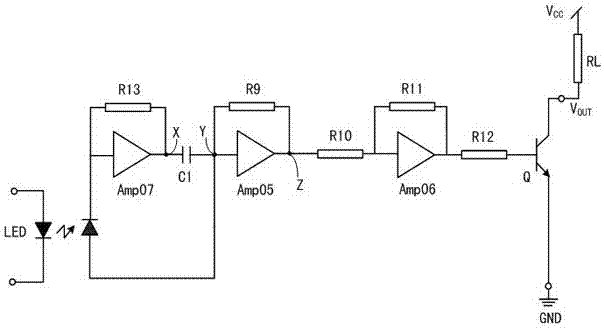light receiving circuit
A technology of optical receiving circuit and main circuit, applied in electromagnetic receivers and other directions, can solve the problems of reducing the voltage swing at point F, the voltage swing is small, the proportion is large, etc., to achieve low transmission delay time, reduce transmission delay, The effect of reducing delay variance
- Summary
- Abstract
- Description
- Claims
- Application Information
AI Technical Summary
Problems solved by technology
Method used
Image
Examples
Embodiment Construction
[0023] A light receiving circuit, the structure of which is: the light receiving circuit is composed of 4 operational amplifiers, 8 matching resistors, an output transistor Q1, an auxiliary transistor Q2 and a photodiode G;
[0024] The input terminal of the first operational amplifier Amp01 is connected with the anode of the photodiode G, the output terminal of the first operational amplifier Amp01 is connected with one end of the second matching resistor R2, and the other end of the second matching resistor R2 is connected with the input of the second operational amplifier Amp02 The output terminal of the second operational amplifier Amp01 is connected to one end of the fourth matching resistor R4, and the other end of the fourth matching resistor R4 is connected to the base of the output transistor Q1; the collector of the output transistor Q1 is open, and the output terminal of the output transistor Q1 Emitter grounded;
[0025]The two ends of the first matching resistor R...
PUM
 Login to View More
Login to View More Abstract
Description
Claims
Application Information
 Login to View More
Login to View More - R&D
- Intellectual Property
- Life Sciences
- Materials
- Tech Scout
- Unparalleled Data Quality
- Higher Quality Content
- 60% Fewer Hallucinations
Browse by: Latest US Patents, China's latest patents, Technical Efficacy Thesaurus, Application Domain, Technology Topic, Popular Technical Reports.
© 2025 PatSnap. All rights reserved.Legal|Privacy policy|Modern Slavery Act Transparency Statement|Sitemap|About US| Contact US: help@patsnap.com



